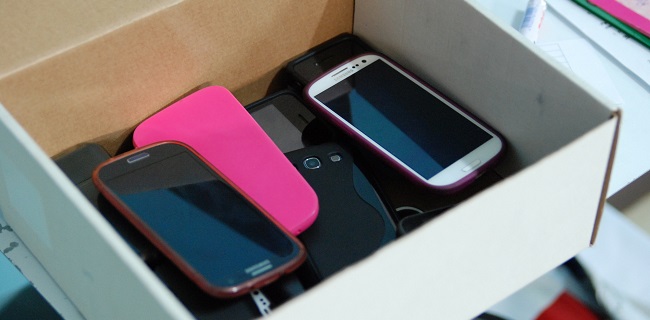Technology in schools has spiraled, and we’ve experienced many different phases. Now it’s time for the next round of development, and this year the most popular back-to-school gadget is the smartphone, which has become a natural addition to the school bag of students in schools across the country. This is not surprising news to anyone, but it does create an issue for many; when students bring their own smartphones onto school property it presents challenges to the e-safety policy. As a diverse area that evolves at a rapid pace, e-safety has very quickly become complex and confusing to tackle.
Mobile devices of one guise or another are here to stay, and with frequency of use on the increase, schools must be on top of the changes this brings, and think about how e-safety prepared their school really is.
Many have good systems in place, but schools also need to consider the new scenario that smartphones add to the mix. Even with robust practices and procedures, students are smart enough to bypass restrictions; to turn off wi-fi on their smartphones and access what they choose to via 3G instead. The message here is that the change in mobile devices means that schools now have to think broader than just managing e-safety at network level. As smartphones and tablets overtake desktops and laptops, it’s crucial to protect at device level too.
Keeping ahead of changes
So what should schools be doing to keep ahead of the mobile device e-safety challenge? There are three options: ban or allow restricted use; allow with security controls; or allow without security controls. Schools must be seen to do everything possible to protect young people; as such, allowing access to mobile devices without security controls is not an option.
The historical default position has been to ban smartphones; either not allowing them onto school property, or phones being deposited in the school office only to be used in an emergency. There are also some that allow students to bring phones into school but they cannot be seen to use them otherwise the devices are taken away. The sustainability of this approach has to be questioned. Firstly, parents have given their child a phone because they want to be able to contact them. Secondly, it becomes a policing nightmare. It’s simply not possible to keep an eye on every student, at every hour of the day to know whether they are using their phone or not.
This leaves the option of allowing access with security controls. Just because schools don’t own the device, it doesn’t mean that schools don’t need to manage it. To ensure schools are clearly demonstrating their duty of care to protect students it is imperative that appropriate security measures are put in place. When reviewing e-safety policies relevant to smartphones, here are some questions to consider:
- Is it possible to timetable internet access?
- Can access to certain apps be restricted?
- Can access be managed in wi-fi and 3G mode?
- Are alerts received when students try to access dangerous content?
- Can camera use be blocked when required?
When schools start to think about how to update e-safety policies to accommodate students’ smartphones, it leads into the whole BYOD debate. A 2011 US publication, The 21st Century Classroom Report, found that 86 per cent of students use more technology out of the classroom than they do in class, and no doubt this is reflected across the UK too.
A BYOD initiative overcomes this access hurdle, much as one-to-one computing programmes do, but without the capital costs associated with purchasing the technology, or the need to refresh, support and train users. However, a BYOD initiative requires a lot more than simply reversing a ban on devices. Schools should plan carefully and ensure that policies and actions are in place to maximise the effectiveness of the BYOD initiative.
Evolving e-safety
e-Safety is an area that will continue to evolve alongside technology innovations, which is why there are always new recommendations to action. It’s an absolute must to undertake regular audits of current policies and procedures to ensure compliance with latest best practice and legislation.
Policies in schools vary from a complete ban to unrestricted use, so unless schools are fully confident that all bases are covered, it is wise to engage external support; not-for-profit organisations, local authorities and commercial companies can all enable schools to have the visibility and tools to manage students’ usage and protect them from harm.
With schools supporting a BYOD environment, most have adequate protection for students’ devices through their network but lack the capability to tackle phones using 3G. For instance, generally web-filtering services on schools’ wi-fi only provides protection for mobile devices on school property. Either inside or outside the school gates, the protection net is no longer there if students use 3G services, which many now will.
Whole school issue
There is a misconception that this is predominantly a secondary school problem, whereas in reality it is a whole school issue which isn’t confined to an older student age group alone. High numbers of young children have smartphones and tablets too; the earlier you look to improve behaviour, the more likely it is to be successful. In fact, the age profile of UK children with smartphones is getting younger. The average British child gets their first mobile phone aged 11 years and 8 months, while 9 per cent of UK children which equates to 1.2 million receive their first mobile phone by the time they are five years old.
This reinforces the importance of an all-round approach to e-safety too. Software needs to be focused on improving student behavior and not just blocking access. Schools today want to give the best possible advice to parents about e-safety, and the schools, parents, teachers and the students themselves all have an important role to play.
With smartphones being the must-have item for young people across the country, this must be reflected in schools’ e-safety policies; round the clock protection should be provided to students using mobile devices. We must work towards ensuring policies are truly fit for purpose, and are capable of responding to the issues that exist in school environments and beyond school boundaries today. An e-safety programme will be most effective with a holistic approach encompassing fixed and mobile technologies, both inside and outside the school gates.
How do you handle mobiles in your school? Let us know in the comments.


















